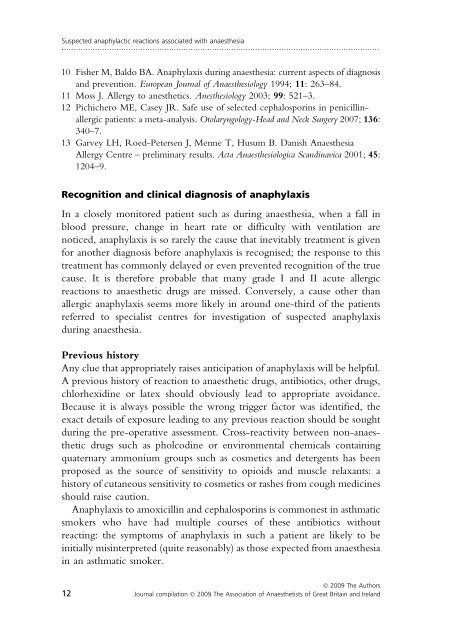Suspected anaphylactic reactions associated with anaesthesia - aagbi
Suspected anaphylactic reactions associated with anaesthesia - aagbi
Suspected anaphylactic reactions associated with anaesthesia - aagbi
- No tags were found...
You also want an ePaper? Increase the reach of your titles
YUMPU automatically turns print PDFs into web optimized ePapers that Google loves.
<strong>Suspected</strong> <strong>anaphylactic</strong> <strong>reactions</strong> <strong>associated</strong> <strong>with</strong> <strong>anaesthesia</strong>.....................................................................................................................................10 Fisher M, Baldo BA. Anaphylaxis during <strong>anaesthesia</strong>: current aspects of diagnosisand prevention. European Journal of Anaesthesiology 1994; 11: 263–84.11 Moss J. Allergy to anesthetics. Anesthesiology 2003; 99: 521–3.12 Pichichero ME, Casey JR. Safe use of selected cephalosporins in penicillinallergicpatients: a meta-analysis. Otolaryngology-Head and Neck Surgery 2007; 136:340–7.13 Garvey LH, Roed-Petersen J, Menne T, Husum B. Danish AnaesthesiaAllergy Centre – preliminary results. Acta Anaesthesiologica Scandinavica 2001; 45:1204–9.Recognition and clinical diagnosis of anaphylaxisIn a closely monitored patient such as during <strong>anaesthesia</strong>, when a fall inblood pressure, change in heart rate or difficulty <strong>with</strong> ventilation arenoticed, anaphylaxis is so rarely the cause that inevitably treatment is givenfor another diagnosis before anaphylaxis is recognised; the response to thistreatment has commonly delayed or even prevented recognition of the truecause. It is therefore probable that many grade I and II acute allergic<strong>reactions</strong> to anaesthetic drugs are missed. Conversely, a cause other thanallergic anaphylaxis seems more likely in around one-third of the patientsreferred to specialist centres for investigation of suspected anaphylaxisduring <strong>anaesthesia</strong>.Previous historyAny clue that appropriately raises anticipation of anaphylaxis will be helpful.A previous history of reaction to anaesthetic drugs, antibiotics, other drugs,chlorhexidine or latex should obviously lead to appropriate avoidance.Because it is always possible the wrong trigger factor was identified, theexact details of exposure leading to any previous reaction should be soughtduring the pre-operative assessment. Cross-reactivity between non-anaestheticdrugs such as pholcodine or environmental chemicals containingquaternary ammonium groups such as cosmetics and detergents has beenproposed as the source of sensitivity to opioids and muscle relaxants: ahistory of cutaneous sensitivity to cosmetics or rashes from cough medicinesshould raise caution.Anaphylaxis to amoxicillin and cephalosporins is commonest in asthmaticsmokers who have had multiple courses of these antibiotics <strong>with</strong>outreacting: the symptoms of anaphylaxis in such a patient are likely to beinitially misinterpreted (quite reasonably) as those expected from <strong>anaesthesia</strong>in an asthmatic smoker.Ó 2009 The Authors12 Journal compilation Ó 2009 The Association of Anaesthetists of Great Britain and Ireland

















